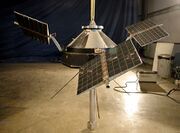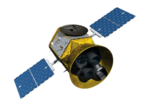Astronomy:Explorer 12
| Mission type | Space Physics |
|---|---|
| Operator | NASA |
| COSPAR ID | 1961-020A |
| SATCAT no. | 170 |
| Website | [1] |
| Mission duration | ~4 months |
| Spacecraft properties | |
| Manufacturer | GSFC |
| Launch mass | 37.6 kilograms (83 lb) |
| Dry mass | 37.6 kilograms (83 lb) |
| Power | Solar |
| Start of mission | |
| Launch date | 16 August 1961, 23:21 UTC |
| Rocket | Thor-Delta |
| Launch site | Cape Canaveral Air Force Station LC-17B |
| End of mission | |
| Last contact | 6 December 1961 |
| Decay date | 1 September 1963 |
| Orbital parameters | |
| Reference system | Geocentric |
| Regime | LEO |
| Eccentricity | 0.84091 |
| Perigee altitude | 790 kilometers (490 mi) |
| Apogee altitude | 77,620 kilometers (48,230 mi) |
| Inclination | 33.4° |
| Period | 1587 minutes |
Explorers | |
Explorer 12 (also known as S3) was a United States Satellite built to measure the solar wind, cosmic rays, and the earth's magnetic field.[1] It was launched on August 16, 1961, aboard a Thor-Delta booster.[2] Explorer 12 was the first of three S3 series spacecraft. It ceased transmitting on December 6 due to power failure.
This satellite was launched from the Atlantic Missile Range by a Delta vehicle on August 15, 1961. Its objective was the investigation solar wind, interplanetary magnetic fields, distant portions of the earth's magnetic field, and energetic particles in interplanetary space and in the Van Allen belt.
The spacecraft weighed 83 pounds. Its instrumentation included 10 particle detection systems for the measurement of protons and electrons and their relation to magnetic fields, a solar cell damage experiment, optical aspect sensor and one transmitter.
The space craft achieved orbit and all instrumentation operated normally. Its transmitter ceased operations on December 6, 1961, after sending 2568 hours of real time data. During its life of 112 days, it completed 102 orbits and data was acquired approximately 80 per cent of the time. This satellite provided significant geophysical data on radiation and magnetic storms. Orbital Elements: Apogee 47,800 statute miles; Perigee 180 statute miles; Orbital Period 46.45 hours. As of July 1962[3] Ref. Original Publication: Profile of a Satellite published by Goddard Space Flight Center / National Aeronautics and Space Administration.
Instruments
Explorer 12 was designed to study space physics, and so had a multitude of instruments including a cosmic-ray detector, a particle trapper, and a magnetometer. Good data was recorded for 90% of the mission.
References



